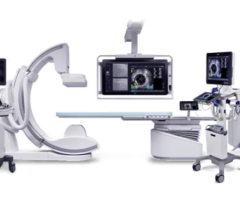
November 7, 2011 — The American College of Cardiology Foundation (ACCF), American Heart Association (AHA), and Society for Cardiovascular Angiography and Interventions (SCAI) released a revised guideline for the management of patients undergoing percutaneous coronary intervention (PCI). The new guideline emphasizes careful consideration before determining treatment for coronary artery disease (CAD), including the use of a “heart team” approach. It also provides the most extensive section yet comparing coronary artery bypass graft surgery (CABG) and PCI, which was co-written by the PCI and CABG writing committees.
“The 2011 guideline includes an unprecedented degree of collaboration in generating revascularization recommendations for patients with CAD,” said Glenn N. Levine, M.D., chair of the PCI guideline writing committee. He noted the extensive CAD revascularization section—which was written together by the PCI and CABG committees—examines both who should be revascularized and which procedure should be used.
The PCI writing committee also worked with members from the CABG, STEMI, stable ischemic heart disease, and unstable angina/non-STEMI guideline committees to determine joint recommendations for their separate documents.
In addition to undergoing a more collaborative writing process, the 2011 writing committee members also added new concepts to the guideline, including that of the “heart team” approach. This approach—which was included as a Class I recommendation (the highest level) for patients with unprotected left main or complex CAD—encourages interventional cardiologists and cardiothoracic surgeons to jointly review the patient’s condition/coronary anatomy; they should also evaluate the pros and cons of each treatment option and then present this information to the patient along with their recommendation.
The new document also advocates using a SYNTAX score in decisions regarding treatment of patients with multivessel disease. This scoring system was introduced in the SYNTAX study published in the New England Journal of Medicine in 2009. It estimates the extent and complexity of CAD by entering the patient’s angiography results into a computer-based “SYNTAX score calculator.”
James C. Blankenship, M.D., vice chair of the PCI guideline writing committee, notes that this calculation is complex; however, using the score to classify extent of disease more objectively may help guide decisions regarding CABG or PCI.
The revised guideline further eliminates ambiguity by providing specific recommendations for the first time for every anatomic subgroup of patients with stable CAD. Recommendations on revascularizing patients are provided based on improving both survival and symptoms.
Blankenship notes it has historically been hard to obtain data for each subgroup, leading to their exclusion from the guideline. The 2011 committee conducted an extensive effort to find information so that each group could be included, whether at a level of evidence A (multiple randomized, controlled trials) or a level of evidence C (expert recommendations or case studies).
According to Levine, great effort was also taken to ensure a “careful and balanced approach” to stenting in general—and drug-eluting stents (DES) in particular—when writing. Specifically, the use of DES to decrease the incidence of blood vessel renarrowing was given a Class I recommendation; this was “counterbalanced” by a recommendation that before PCI, physicians must first evaluate patients to determine if they can tolerate and comply with dual antiplatelet therapy.
Levine notes the committee simplified the recommendations regarding aspirin by including a Class IIA recommendation (meaning “it is reasonable”) for using 81 mg of aspirin daily after PCI instead of higher maintenance doses. The committee also provided recommendations regarding the use of ticagrelor, a new P2Y12 inhibitor approved by the FDA after the release of the previous guideline.
Alongside Class I recommendations for clopidogrel and prasugrel, the committee provided a Class I recommendation for giving 180 mg of ticagrelor as a loading dose; they also recommended giving 90 mg twice daily for at least 12 months following PCI with either a DES or bare-metal stent (BMS).
The new document expands and adds recommendations on numerous other topics. Ethical aspects of PCI—including informed consent, self-referral, and potential conflicts of interest—are addressed; there are also recommendations on statin therapy, the use of vascular closure devices, and PCI in hospitals without onsite surgical backup. The guideline also includes a Class I recommendation for monitoring and recording procedural radiation data.
The 2011 guideline was written under a new policy implemented by the ACC and AHA. It requires more than 50 percent of the writing committee members—and the committee chair—to be free of relevant industry relationships.
Watch the VIDEO “How to Build An Integrated Heart Team.” Brijeshwar Maini, M.D., and Brian Bethea, M.D., from Tenet Florida’s structural heart program, explain the importance of building a good heart team and how that team should interact.
For more information: www.cardiosource.org; www.heart.org; www.scai.org


 December 20, 2023
December 20, 2023 








